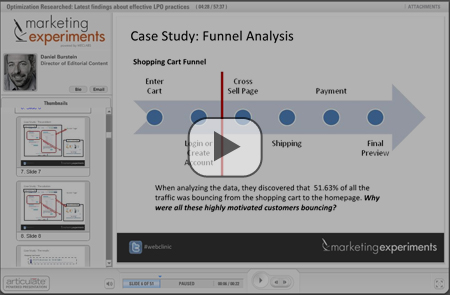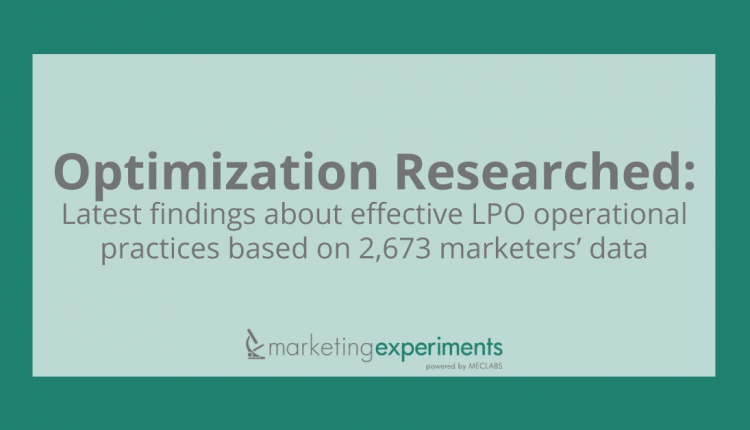Optimization Researched
Latest findings about effective LPO operational practices based on data from 2,673 marketers
After initial introductions, Daniel jumped right in with a case study illustrating how many companies tend to throw more money at leaky sales funnel, instead of fixing those leaks. In the case study, however, a marketing manager makes a simple fix in the shopping cart of the website and gets a 43 percent increase in conversions.
Boris then discussed how marketing managers need to optimize to seal the leaks in their conversion funnels before investing money and resources into driving additional traffic. Otherwise they’re just losing even more money.
The problem is that though we can all agree that optimization testing is a worthwhile endeavor, actually making it happen operationally is very challenging for most marketers. As Boris stated in his presentation, only 21 percent base their marketing decisions on test data.
So to help marketers overcome these common challenges, we sought to help them answer three questions to launch and operationalize optimization in their organizations:
Question 1: What is the state of LPO among your peers?
The first step to building a case for LPO is to demonstrate its prominence and successes in other organizations. “Some business leaders need to know what their peers are doing before they can make a decision,” said Daniel
Going back to the Benchmark Report, Boris proceeded to explain that while LPO is in its early stages, marketers that are engaged in it have demonstrated outsized returns. Only 36 percent of organizations surveyed in Boris report say they are testing, but given the relatively more motivated sample (marketers unaware of LPO were under- or un-represented in the survey), testing is practiced even less across the board. There is plenty of opportunity for organizations who are just getting started to out-perform their competition and peers with highly optimized landing pages.
Question 2: How are marketers filling the resource gap?
Quoting MECLABS Senior Director of Business Development, Todd Lebo, Daniel said that “as marketers, we are essentially all optimizers. We are all trying to constantly improve our efforts to get more leads or sales.” But that doesnt mean that there arent some specific expertise and resource gaps that you need to fill.
According to the Benchmark Report, marketers are filling the resource gap by both hiring in-house optimizers and outsourcing. As Boris stated, “having committed, in-house staff is extremely valuable as optimization should be part of essential marketing operations.” If marketers do choose to outsource, it is still invaluable to have in-house experts to help consultants do their jobs better. Unfortunately, many marketers are still struggling to fill this gap as only 52 percent of LPO projects reach a productive result.
Question 3: How do I develop a proposed optimization plan?
“In the end, if youre going to make that business case, you need to develop an optimization plan. We want to help you develop that plan.”
To that end, Boris created what he called a “Master Task List.”
STEP 1: Define Objectives
First, Boris defined LPO as the intersection of website objectives and visitor preferences. “Explicitly determining the objective is absolutely critical. You should try to narrow everything down to one specific outcome.” To illustrate the point, Boris laid out a simple three-step exercise:
- Start with your business objective(s)
- Understand how your business objectives map to your website objectives
- Explicitly define website objectives in terms of visitors target actions
STEP 2: Understand visitor preferences and motivations
Boris stated that “getting a human to behave in a certain way on your landing pages means communicating an offer in a way that matches those visitor preferences and motivations.” To do that, you need to:
- Identify pages or paths that contribute to conversion using Web analytics
- Perform data analysis to identify “leaks” in paths toward the objective
- Identify significant visitor segments, at least by traffic source
STEP 3: Create relevant, value-driven experiences
“In a good restaurant, the waiter will ask you questions to help you choose the right thing and not just wait for you to point to an item on the menu. With a well-optimized website, it works the same way.” You need to understand what your visitors want to create relevant experiences. There are two things you should do to accomplish that:
- Create dedicated landing pages or dynamically create segment-specific experiences
- Use what you know about visitor preferences based on easily accessible data (see slide 46 for a chart of types of data marketers use)
This Web clinic was significantly different than most of the Web clinics you will find in our Research Directory. It was advertised as a Web clinic on establishing LPO operations, yet our audience has been accustomed to more tactical topics, which was reflected in their expectations. It was interesting that in response to the question “What are your most pressing OPERATIONAL issues related to LPO?” that was asked on the registration form, most marketers still asked about long vs. short copy and button design.
While much of our research focuses on LPO tactics, in this Web clinic our goal was to arm you with the research to gain the resources you need to begin optimizing in your organization or with your clients.
Here are what some of the audience members had to say about this Web clinic:
“The outsourcing LPO functions slides were very insightful and confirmed my intuitive conclusion from conversations that I have had.” —Carl
“I expected to get more details about specific LPO practices. This was a nice overview, but did little in terms of specific actionable items.” —Michelle
“Very in depth presentation” —Mia
“I expected this webinar to be about how to improve landing pages. Instead, it was about showing how LPO is important but not enough people are doing it. Your webinars usually offer some useful nuggets of information, but this one did not.” —Steven
Download a full transcript of this Web clinic:
View the clinic replay, or listen to the audio recording (mp3), to learn from our researchers as they discuss how to overcome operational issues in LPO.

Presentation will open in new window
Credits:
Presenters
Boris Grinkot
Daniel Burstein
Writers
Boris Grinkot
Daniel Burstein
Paul Cheney
Austin McCraw
Technical Production
Joelle Parra
Nicole Evans
Bethany Claudell
Bob Kemper
Cliff Rainer
Additional Contributors
Todd Lebo




